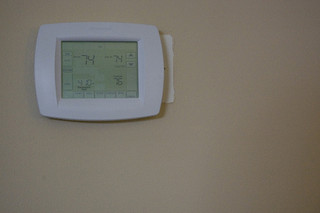AARP Eye Center
Programmable Thermostats: Savings or Not?
By Jeff Yeager, October 28, 2013 12:44 PM

A couple of years ago I wrote an article for AARP about simple ways to reduce the cost of heating your home. After reading it, my wife promptly added a number of the energy-saving tips I'd suggested to my "honey-do" list, including installing three programmable thermostats around our house.
The good news was that the new thermostats were inexpensive and easy to install. We found a three-pack on sale at a home improvement center for $70, and, much to my wife's amazement, I actually had all three set up and operating properly before we sat down to dinner. Check another item off Jeff's list.
>> Sign up for the AARP Money Matters newsletter
But in the winters since, we haven't seen a significant decline in our home heating costs or energy usage, allowing for fluctuations in fuel oil prices and similar, although not identical, temperature patterns during each of those winters. As it turns out, our experience with programmable thermostats - that they don't produce the savings we'd expected - is fairly common.
Several recent studies have shown no significant savings in households using programmable thermostats compared with households in which occupants set the thermostats manually. What's worse, at least two studies found that residents who relied on these thermostats actually used more energy.
The problem, according to a 2011 research paper from the Lawrence Berkeley National Laboratory and the University of California, Davis, is that many people fail to install and use programmable thermostats properly. The researchers also found that programmable thermostats can be an effective tool in reducing home energy costs.
Here's what you need to know:
- In the winter, program your thermostat at 68 degrees while you're awake and at home. Set it to automatically lower home temperatures by 10 to 15 degrees while you're away or sleeping (that is, if you don't mind sleeping in a chilly room). In the summer, set it at 78 degrees when you're at home and need cooling.
- Enter multiple programs to fit your lifestyle, for example, for weekends or for certain days of the weeks when your schedule is different than usual.
- Install thermostats on interior walls, out of direct sunlight and away from windows and doors, and in rooms where natural air currents (warm air rising, cool air sinking) occur.
By doing these things and automatically lowering your thermostat by 10 to 15 degrees for eight hours a day, you can save 5 percent to 15 percent on your heating bill this winter, the government says. Check the U.S. Department of Energy and EPA/Energy Star websites for detailed instructions on properly installing and operating programmable thermostats.
>> Get discounts on financial products and services with your AARP Member Advantages. <<
In our case, I had already been a human thermostat programmer, religiously turning down the heat when we were away or asleep, and not cranking it up too much when we were at home and awake. Now that we have the thermostats programmed properly, my wife no longer harangues me for constantly fiddling with the units to save a few bucks. And that's priceless.
Photo: Mandy Jansen/Flickr

Also of Interest
- Best Kept Secret: Wait Until 70 to Collect Social Security
- Slideshow: 10 DIY Home Improvement Fixes
- Shopping for health insurance? The health insurance marketplace is now open
- Join AARP: Savings, resources and news for your well-being
See the AARP home page for deals, savings tips, trivia and more























































